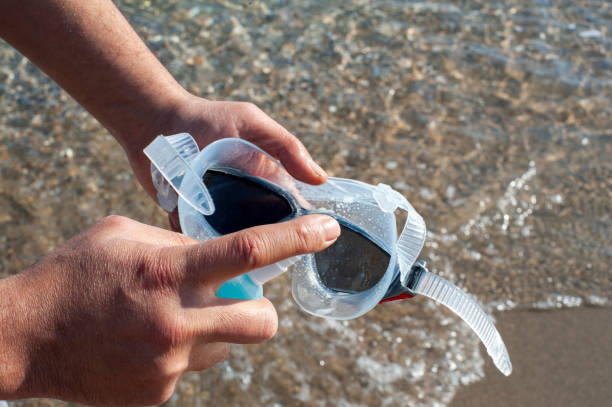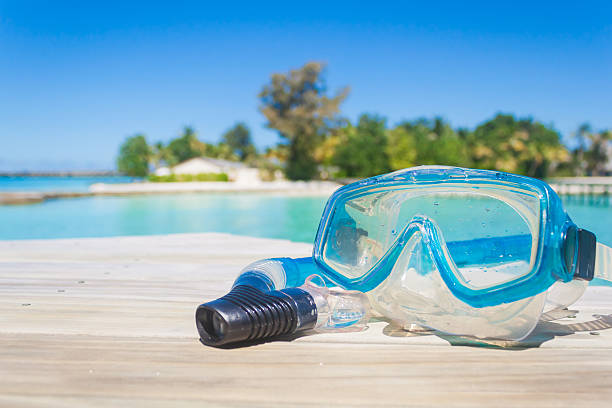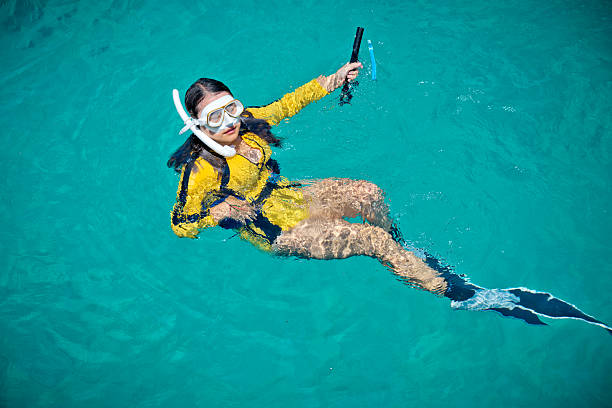수영 조끼란 무엇일까요? 수영 조끼는 아이들의 물놀이 안전을 위해 필수적인 요소로, 중요한 부력을 제공합니다. 특히 1~4세 어린이에게는 익사가 심각한 위험 요소이므로, 수영 조끼는 사고 예방에 중요한 역할을 합니다. 이 블로그는 어린이의 물놀이 안전을 증진하고 부모에게 수영 조끼의 중요성을 알리는 데 있어 수영 조끼의 중요성을 강조합니다. 수영 조끼가 올바른 수영 자세를 유도하고 자신감을 키워주는 방식을 이해하는 것은 아이들이 안전하고 즐거운 물놀이를 즐길 수 있도록 하는 데 매우 중요합니다.
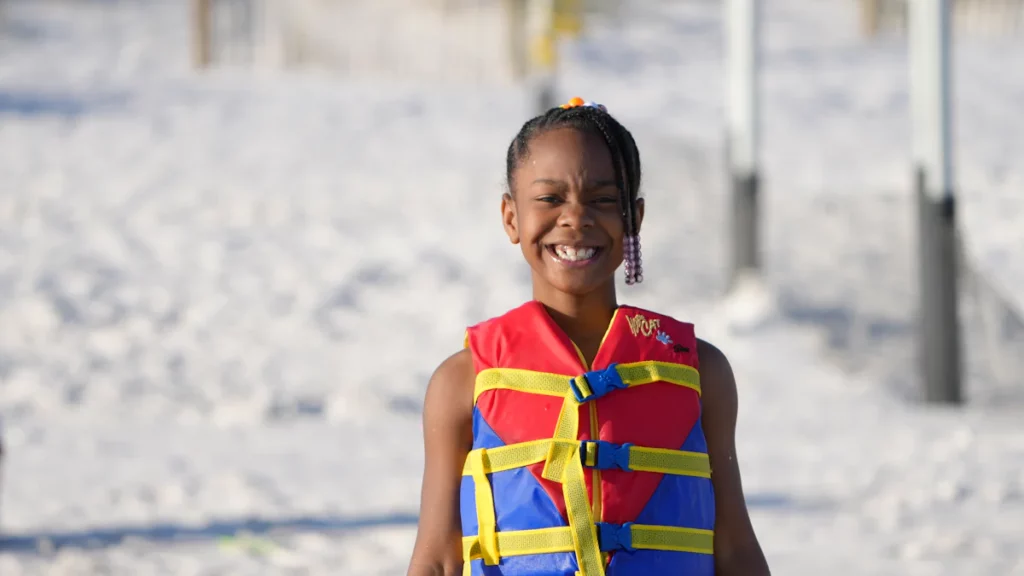
수영 조끼란 무엇인가?
플로트 조끼와 재킷은 아이들이 수영을 배울 때 물속에서 자연스러운 자세를 취할 수 있도록 수영복이나 반바지 위에 착용하는 제품입니다. 부력 보조 장치 역할을 하여 아이의 자연스러운 부력을 활용하여 물속에서 안전을 강화합니다. 이 재킷에는 탈부착 가능한 플로트가 있어 아이의 자신감과 수영 실력이 향상됨에 따라 점차적으로 탈부착할 수 있습니다. 또한, 더욱 편리한 사용을 위해 탈부착이 불가능한 플로트가 있는 조끼도 있습니다.
다른 부유 장치와의 비교
수영 조끼와 구명조끼를 비교할 때, 수영 조끼는 수영장과 같이 통제된 환경에서 수영을 배우는 아이들에게 유익하다는 점을 꼭 기억해야 합니다. 구명조끼와 달리, 구명조끼는 구명조끼와 같은 수준의 보호력이나 부력을 제공하지 않으므로 구명조끼가 필요한 상황에서는 사용해서는 안 됩니다. 수영 조끼는 수영장과 같이 잔잔한 물에서 구명조끼보다 더 자유롭게 움직일 수 있도록 특별히 설계되어, 감독 하에 수영 기술을 연습하기에 이상적입니다.
수영 조끼는 몇 살부터 착용할 수 있나요?
수영 조끼 어린아이들이 물에서 탐험하고 헤엄치는 법을 배우기 시작하는 데 필수적인 도구입니다. 이 조끼는 부력과 지지력을 제공하도록 설계되어 아이들이 수영 실력을 키우는 동안 안전하고 자신감 있게 수영할 수 있도록 도와줍니다. 일반적으로 수영 조끼는 1세에서 8세 사이의 어린이를 대상으로 하지만, 정확한 연령대는 브랜드와 모델에 따라 다를 수 있습니다.
영유아, 특히 12개월에서 18개월 사이의 유아에게 수영 조끼는 물놀이 안전에 중요한 역할을 합니다. 12개월 된 아기는 물에 익숙해지기 시작하는 시기이므로, 수영 조끼는 충분한 부력과 머리 지지대를 제공해야 합니다. 조끼는 아이가 미끄러지지 않도록 안전하게 착용해야 하며, 조절 가능한 끈은 아기의 성장에 따라 조끼가 자연스럽게 자라도록 도와줍니다.
- 메모: 12개월 된 아기를 위한 수영 조끼를 선택할 때는 유아용으로 특별히 디자인된 모델을 찾으세요. 이 모델은 최대한의 안전과 편안함을 제공하기 위해 가랑이 끈과 패딩 처리된 머리 받침과 같은 기능을 제공해야 합니다.
아이들이 성장하고 물에서 더 활발해짐에 따라 수영 조끼에 대한 요구 사항도 달라집니다. 예를 들어, 15개월 된 아기에게 가장 적합한 수영 조끼는 부력뿐만 아니라 더 큰 움직임의 자유도 제공해야 합니다. 이 시기의 아이들은 물속에서의 이동성을 탐구하기 시작하며, 잘 디자인된 수영 조끼는 안전을 보장하는 동시에 기본적인 수영 기술을 발달시키는 데 도움을 줄 수 있습니다.
- 메모: 내구성이 뛰어나고 편안한 소재로 제작되어 마찰이나 움직임에 불편함이 없는 조끼를 찾으세요. 잡기 쉬운 손잡이 등 안전 기능이 있는 밝은 색상의 조끼는 필요한 경우 신속한 구조에 특히 유용합니다.
16개월에서 18개월이 되면 수영 조끼는 아이의 자신감과 활동량이 증가하는 것을 고려하면서도 튼튼한 지지력을 제공해야 합니다. 16개월 아기용 수영 조끼는 몸에 꼭 맞도록 조절 기능이 있어야 하며, 아이의 움직임을 방해하지 않을 만큼 가벼워야 합니다. 조끼는 부력과 유연성의 균형을 잘 맞춰 아이가 무거운 느낌 없이 발차기와 패들링을 연습할 수 있도록 해야 합니다.
마찬가지로, 18개월 된 아기를 위한 수영 조끼는 모험심이 많고 호기심이 많은 수영 선수를 위한 것이어야 합니다. 이러한 조끼는 상당한 부력을 제공하는 동시에, 아이가 자연스러운 수영 자세를 유지하도록 하여 수영 기술 발달을 촉진해야 합니다. 자외선 차단 기능이 내장된 조끼는 안전과 자외선 차단 기능을 모두 제공하여 야외 수영에 매우 적합한 선택입니다.
수영 조끼의 장점

수영은 필수적인 기술이며, 수영 조끼는 어린아이들이 안전하고 자신감 있게 수영을 배우는 데 중요한 역할을 합니다. 어린이 수영 조끼 사용의 이점을 살펴보겠습니다.
강화된 안전성
수영 조끼는 어린 수영 선수에게 부력을 제공하고 익사 사고를 예방하여 중요한 안전을 제공합니다. 질병통제예방센터(CDC)에 따르면, 익사는 1~4세 아동의 부상 관련 사망 원인 중 가장 큰 비중을 차지합니다. 수영 조끼는 아이들이 물에 떠 있도록 하여 이러한 위험을 줄이는 데 도움이 되며, 부모는 지속적인 신체적 지원보다는 감독에 집중할 수 있습니다.
자신감 구축
수영 조끼는 아이의 물에서의 자신감을 크게 높여줍니다. 미국 적십자사에서 실시한 연구에 따르면 수영 보조 장비를 사용한 아이들은 수영 강습과 수상 활동에 참여할 가능성이 더 높았습니다. 예를 들어, 조끼를 착용하고 수영을 배우는 세 살짜리 아이는 수영장을 자유롭게 탐험할 수 있으며, 점점 더 편안하고 능숙해짐에 따라 조끼에 대한 의존도를 점차 줄일 수 있습니다.
올바른 수영 자세
수영 조끼는 효과적인 수영 기술을 익히는 데 필수적인 올바른 수영 자세를 길러줍니다. 아이의 몸을 수평으로 유지하고 머리를 물 위로 올려줌으로써 자연스러운 수영 자세를 만들어 줍니다. 수영 학원에서 조끼를 입은 아이들이 조끼를 입지 않은 아이들보다 신체 정렬이 향상되고 수영 레벨이 더 빠르게 상승하는 실제 사례가 있습니다.
독립성과 이동성
수영 조끼는 아이들이 물속에서 스스로 움직일 수 있게 해 주어 자율성을 키워줍니다. 예를 들어, 한 부모는 처음에는 물을 무서워하던 두 살배기 아이가 수영 조끼를 입고 수영을 즐기기 시작했다는 이야기를 들려주었습니다. 조끼 덕분에 아이는 수영장에서 스스로 헤엄칠 수 있는 자유를 얻었고, 덕분에 수상 활동이 더 즐겁고 덜 위협적으로 느껴졌습니다.
수영 조끼의 종류
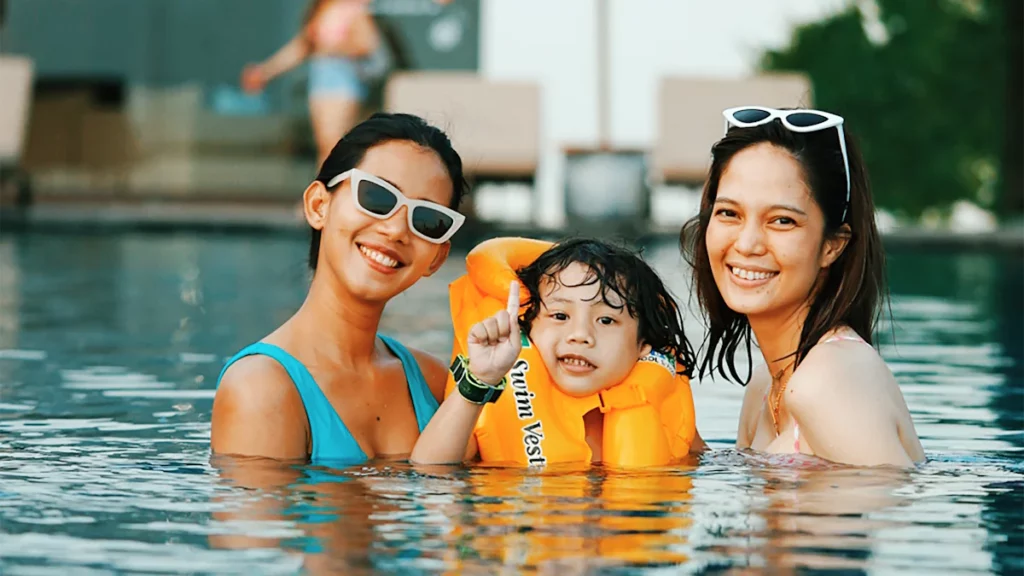
아이에게 맞는 수영 조끼를 선택할 때는 다양한 종류의 조끼를 이해하는 것이 중요합니다. 조끼는 소재, 디자인, 연령별 기능이 각기 다르기 때문에 다양한 요구를 충족할 수 있습니다.
재료 유형
1. 네오프렌 수영 조끼
네오프렌은 내구성과 부력 덕분에 수영 조끼 소재로 널리 사용됩니다. 네오프렌 수영 조끼는 뛰어난 보온성을 제공하여 차가운 물에서 활동하기에 이상적입니다. 몸에 꼭 맞는 핏으로 아이를 따뜻하고 안전하게 보호해 줍니다. 또한, 네오프렌 조끼는 마모에 강하여 여러 시즌 동안 착용할 수 있습니다. 이러한 유형의 예로는 18개월 아기용 네오프렌 수영 조끼물속에서 추위를 느낄 수 있는 어린 수영 선수에게 필수적인 편안함과 따뜻함을 겸비한 제품입니다.
2. 나일론 수영 조끼
나일론은 수영 조끼에 흔히 사용되는 소재입니다. 나일론 수영 조끼는 가볍고 속건성이 뛰어나 자주 사용하거나 여행할 때 편리합니다. 네오프렌 조끼보다 가격이 저렴하며 다양하고 밝은 색상과 재미있는 디자인으로 출시됩니다. 충분한 부력을 제공하고 세탁이 간편하여 바쁜 부모에게 특히 유용합니다. 예를 들어, 15개월 아기에게 가장 좋은 수영 조끼 안전성과 사용 편의성을 모두 갖춘 나일론 조끼가 될 수 있습니다.
3. 폼 수영 조끼
폼 수영 조끼는 일반적으로 부력이 있는 폼을 여러 겹으로 꿰맨 형태로 제작됩니다. 이 조끼는 공기를 주입하지 않고도 일정한 부력을 제공하여 어린 수영 선수들에게 믿음직한 선택입니다. 폼 조끼는 내구성이 뛰어나 구멍이 나거나 손상되어도 부력을 유지합니다. 안정적이고 믿을 수 있는 부력 보조 기구가 필요한 어린이에게 탁월한 선택입니다. 12개월 아기용 수영 조끼 폼으로 만든 제품은 유아가 처음 물을 마실 때 필요한 안정성과 보안을 제공할 수 있습니다.
디자인 변형
1. 기본 수영 조끼
기본 수영 조끼는 디자인이 간결하며, 부력 제공과 아이의 수면 유지에 중점을 둡니다. 일반적으로 조절 가능한 스트랩이 있어 안정적으로 착용할 수 있으며, 다양한 사이즈와 색상으로 출시됩니다. 이 조끼는 수영을 처음 시작하는 초보자에게 안정적인 지지력이 필요한 분들에게 이상적입니다. 군더더기 없이 실용적인 수영 조끼를 찾는 부모들에게도 흔히 선택되는 제품입니다.
2. 팔 부표가 달린 수영 조끼
일부 수영 조끼에는 팔에 부착할 수 있는 부력이 내장되어 있어 추가적인 부력을 제공하고 아이들이 올바른 수영 자세를 유지하는 데 도움을 줍니다. 이러한 디자인은 특히 팔과 어깨에 추가적인 지지력이 필요한 어린 수영 선수에게 유용합니다. 팔에 부력이 더해지면 아이들이 패들링과 킥을 더 효과적으로 배우는 데 도움이 됩니다. 16개월 아기용 수영 조끼 팔에 부착할 수 있는 부표는 물에 대한 자신감을 갖기 시작한 유아에게 필요한 추가적인 부력을 제공할 수 있습니다.
3. 풀바디 수영 조끼
전신 수영 조끼는 아이의 상체를 더 많이 덮으며, 다리 끈이나 머리 지지대와 같은 추가 기능이 있는 경우도 있습니다. 이러한 조끼는 최대한의 안전을 위해 설계되었으며, 영유아에게 자주 사용됩니다. 전신 조끼는 아이가 안전하고 안정적인 자세를 유지하도록 하여 물속에서 뒤집힐 위험을 줄여줍니다. 어린 자녀에게 최고의 보호를 원하는 부모에게 안성맞춤입니다.
연령별 디자인
1. 유아용 수영 조끼
유아용 수영 조끼는 일반적으로 생후 6개월에서 2세 사이의 어린 수영 선수를 위해 설계되었습니다. 이 조끼는 패딩 처리된 머리 받침대, 가랑이 끈, 조끼를 제자리에 고정하는 안전한 버클과 같은 기능을 갖추고 있어 안전과 편안함을 최우선으로 합니다. 유아용 조끼는 아기의 머리가 물 위로 나오도록 가슴과 등 주변에 더 많은 부력을 제공하는 경우가 많습니다. 12개월 아기용 수영 조끼 유아가 수영장에서 처음 경험하는 데 필요한 지원을 제공하는 것이 이 범주에 속합니다.
2. 유아용 수영 조끼
유아용 수영 조끼는 2~4세 어린이를 위해 디자인되었습니다. 이 조끼는 균형 잡힌 부력을 제공하여 유아가 물에 뜨고 노를 젓는 법을 배우는 데 도움을 줍니다. 밝은 색상과 재미있는 디자인으로 어린아이들의 관심을 사로잡습니다. 조절 가능한 스트랩과 안전한 잠금장치가 편안한 착용감을 제공하여 유아가 물속에서 자유롭고 편안하게 움직일 수 있도록 도와줍니다. 15개월 아기에게 가장 좋은 수영 조끼 특히 아이가 몸집이 크고 성장에 필요한 공간이 조금 더 필요한 경우 이 범주에 해당할 수 있습니다.
3. 미취학 아동 수영 조끼
미취학 아동용 수영 조끼는 4세에서 6세 사이의 어린이를 위한 제품입니다. 이 조끼는 몸을 지지하는 동시에 더욱 발전된 수영 동작을 할 수 있도록 설계되었습니다. 아이들이 보조 수영에서 자립 수영으로 전환하는 과정에서 자신감을 키우는 데 도움을 줍니다. 탈착식 부력 패드와 같은 기능을 통해 아이의 수영 실력 향상에 따라 부모가 부력을 조절할 수 있습니다. 16개월 아기용 수영 조끼 아이의 성장에 맞춰 디자인을 조절할 수 있다면 고려해 볼 만합니다.
가벼운 수영 조끼 추천
가벼운 수영 조끼는 아이의 편안함과 물에서의 움직임에 큰 변화를 줄 수 있습니다. 가벼운 조끼는 필요한 부력을 제공하는 동시에 더 많은 자유와 유연성을 제공합니다. 가벼운 수영 조끼 브랜드 세 곳과 어린 수영 선수들에게 주목할 만한 Vanguard 수영 조끼를 소개합니다.
뱅가드 수영 조끼
뱅가드 수영 조끼는 믿을 수 있고 가벼운 수영 조끼를 찾는 부모님들에게 최고의 선택입니다. 혁신적인 디자인과 고품질 소재로 유명한 뱅가드 수영 조끼는 뛰어난 부력과 편안함을 제공합니다. 가볍지만 내구성이 뛰어난 소재로 제작되어 아이의 물속 움직임을 방해하지 않습니다. 조절 가능한 스트랩과 안전한 버클이 있어 아이의 성장에 맞춰 편안하게 착용할 수 있습니다. 다양한 연령대의 어린이에게 적합한 뱅가드 수영 조끼는 어린 수영 선수들이 안전하고 편안하게 자신감을 키우고 실력을 향상시킬 수 있도록 설계되었습니다.
스턴스 퍼들 점퍼
Stearns Puddle Jumper는 아동용 수영 조끼 업계에서 유명한 브랜드입니다. Stearns Puddle Jumper 제품은 뛰어난 부력과 안전성을 제공하면서도 편안함을 잃지 않도록 설계되었습니다. 내구성이 뛰어난 나일론과 부드러운 폼 소재로 제작된 가벼운 디자인으로 아이가 물속에서도 무거워지지 않습니다. 해안경비대 인증을 받았으며, 다양하고 재미있는 디자인과 밝은 색상으로 출시되어 아이들의 눈길을 사로잡습니다. 13.5~23.7kg(30~50파운드)의 어린이에게 적합하여 유아 및 미취학 아동에게 좋은 선택입니다.
스피도 비긴 투 스윔 클래식 수영 조끼
Speedo는 수영복 및 수영 용품 분야에서 신뢰받는 브랜드이며, Begin to Swim Classic Swim Vest도 예외는 아닙니다. 이 조끼는 가볍고 어린 수영 선수들의 활동성을 극대화하도록 설계되었습니다. 네오프렌 소재로 제작되어 뛰어난 부력과 내구성을 자랑합니다. 조끼에는 안전 스트랩이 있어 안정적으로 착용할 수 있으며, 조끼가 흘러내리는 것을 방지합니다. 수영을 처음 시작하는 아이들에게 적합하며, 실력 향상에 필요한 자신감을 키워줍니다. Speedo 수영 조끼는 2~4세, 최대 15kg(33파운드)의 어린이에게 적합합니다.
콘피던스 오리지널 재킷
콘피던스 오리지널 재킷은 가벼운 수영 조끼로 또 다른 훌륭한 선택입니다. 고품질 네오프렌 소재로 제작되어 보온성, 부력, 그리고 유연성을 제공합니다. 8개의 탈착식 부력 패드를 통해 부력을 조절할 수 있어, 부모는 아이의 수영 실력 향상에 따라 부력 수준을 조절할 수 있습니다. 밝은 노란색 뒷면은 아이가 물속에 있는지 쉽게 알아볼 수 있도록 해줍니다. 콘피던스 재킷은 선택 사이즈에 따라 생후 18개월부터 7세까지의 어린이에게 적합합니다.
수영 조끼를 입고 수영하는 방법? 9가지 활용 팁
수영 조끼를 입고 수영하는 것은 아이들과 초보자들이 자신감을 키우고 수영의 기본기를 익히는 좋은 방법입니다. 수영 조끼를 효과적으로 활용하는 몇 가지 유용한 팁을 소개합니다.
1. 적절한 핏을 확인하세요
수영 조끼는 꼭 맞되 너무 조이지 않아야 미끄러짐 없이 편안하게 움직일 수 있습니다. 끈과 버클을 조절하여 조끼를 단단히 고정하세요. 아이가 물속에 있을 때 조끼가 턱이나 귀 위로 올라가지 않도록 하세요. 만약 올라간다면 조끼가 너무 헐렁한 것이므로 더 안전하게 착용하려면 조여주세요.
2. 얕은 물에서 시작하세요
얕은 물에서 시작하는 것은 조끼의 부력에 익숙해지는 효과적인 방법입니다. 아이가 수영장의 얕은 쪽을 걷거나 걸어 다니면서 조끼가 아이를 어떻게 지지하는지 느껴보도록 하세요. 조끼가 어떻게 아이를 떠받쳐 주는지 느껴보도록 아이가 뒤로 살짝 기대도록 격려하세요. 이렇게 통제된 환경은 자신감과 편안함을 키우는 데 도움이 됩니다.
3. 플로팅 연습
조끼가 제공하는 부력과 균형감에 익숙해지려면 물에 뜨는 연습이 필수적입니다. 아이가 앞뒤로 떠 있는 동안 처음에는 머리와 등을 받쳐주세요. 아이가 편안해지면 천천히 놓아주면서 자세를 유지하도록 하세요. 균형을 더 잘 잡기 위해 팔과 다리를 벌리도록 격려하고, 조끼가 제공하는 지지력을 이해하도록 도와주세요.
4. 기본 발차기 소개
기본적인 발차기 기술을 가르치면 아이가 조끼를 입은 채로 물속에서 움직이는 데 도움이 됩니다. 플러터 킥을 연습하는 동안 아이에게 수영장 가장자리나 킥보드를 잡도록 하세요. 다리를 곧게 펴고 무릎이 아닌 엉덩이로 발차기를 하도록 하세요.
5. 팔 움직임을 장려하세요
발차기와 팔 동작을 결합하면 아이가 수영을 위해 팔다리를 협응하는 법을 배우는 데 도움이 됩니다. 아이에게 개 헤엄이나 앞으로 기어가기 같은 기본적인 영법을 보여주세요. 발차기를 하면서 팔을 뻗어 앞으로 나아가도록 격려해 주세요.
6. 더 깊은 물로의 점진적인 진행
점차적으로 더 깊은 물로 이동하면 아이가 수영 조끼에 더 자신감을 갖고 편안하게 적응하는 데 도움이 됩니다. 아이가 자신의 속도에 맞춰 더 깊은 물을 탐험할 때 아이 곁에서 안심시켜 주세요. 조끼의 지지력으로 아이가 안전하다고 느낄 수 있도록 항상 도와주고, 점진적으로 자신감을 키워주세요.
7. 재미있는 물놀이 게임을 하세요
재미있는 게임과 활동을 접목하면 수영을 즐겁고 덜 위협적으로 만들 수 있습니다. "빨간불, 초록불"이나 물에서 물건 가져오기 같은 게임은 아이들이 수영 실력을 연습하면서 두려움을 잊고 즐거운 시간을 보내는 데 도움이 됩니다. 이러한 놀이적인 접근 방식은 즐거움을 통해 학습을 촉진합니다.
8. 조끼에서 벗어나기
아이가 수영 실력과 자신감이 향상됨에 따라 수영 조끼에 대한 의존도를 점차 줄이는 것이 발달에 중요합니다. 얕은 물에서 조끼 없이 보내는 시간을 짧게 하고, 실력이 향상됨에 따라 점차 시간을 늘려가세요. 아이의 발전 과정을 칭찬해 주면 자신감을 키우고 지속적인 학습을 장려할 수 있습니다.
결론
요약하자면, 수영 조끼가 무엇이고 그 장점을 이해하면 아이의 수영 경험을 크게 향상시킬 수 있습니다. 수영 조끼는 필수적인 부력과 지지력을 제공하여 아이들이 올바른 수영 자세를 유지하고 중요한 기술을 발달시키는 데 도움을 줍니다. 다양한 연령과 필요에 맞춰 디자인된 다양한 종류의 조끼가 있어 적합한 조끼를 선택하는 것이 그 어느 때보다 쉬워졌습니다. 수영 조끼를 구매하여 아이의 수영 경험을 더욱 안전하고 즐겁게 만들어 보세요. 어린 수영 선수에게 수영 조끼를 착용시켜 물에서 자신감과 실력이 향상되는 모습을 지켜보세요.
자주 묻는 질문
질문 1: 1살짜리 아기가 수영 조끼를 사용할 수 있나요?
네, 1세 아기도 수영 조끼를 사용할 수 있지만, 유아용으로 특별히 고안된 조끼를 선택하는 것이 중요합니다. 이 조끼는 아주 어린 아이들의 필요에 맞춰 적절한 부력과 안전 기능을 제공하여, 아이들이 물에서 즐거운 시간을 보내는 동안 물에 뜨고 편안하게 지낼 수 있도록 도와줍니다.
Q2: 수영 조끼는 몸을 따뜻하게 유지해 주나요?
네오프렌과 같은 소재로 만든 수영 조끼는 물속에서 체온을 유지하는 데 도움이 됩니다. 네오프렌은 단열 기능을 제공하여 체온을 유지해 주므로 시원한 수영 환경에서 수영 조끼를 착용하는 데 이상적입니다. 네오프렌의 주요 기능은 아니지만, 이러한 보온 기능은 장시간 물속에서 편안함을 높여줍니다.
Q3: 조끼의 목적은 무엇인가요?
수영 조끼의 목적은 부력과 지지력을 제공하여 수영 선수, 특히 초보자와 어린이가 물에 떠 있고 올바른 수영 자세를 유지할 수 있도록 돕는 것입니다. 수영 조끼는 안전과 자신감을 높여 사용자가 가라앉을 걱정 없이 수영 기술 학습에 집중할 수 있도록 해줍니다.
Q4: 수영 조끼는 무슨 역할을 하나요?
수영 조끼는 물속에서 부력과 지지력을 제공하여 사용자, 특히 어린이가 물에 떠 있고 올바른 수영 자세를 유지하는 데 도움을 줍니다. 또한, 자신감과 안전성을 높여 초보자가 물에 빠질 위험 없이 수영 기술을 배우고 연습할 수 있도록 하여 더욱 즐거운 물놀이를 선사합니다.
Q5: 수영 조끼는 얼마나 꼭 맞아야 하나요?
수영 조끼는 꼭 맞아야 하지만 너무 조여서는 안 됩니다. 호흡을 방해하거나 불편함을 유발하지 않으면서 편안하게 움직일 수 있어야 합니다. 스트랩과 버클을 조절하여 조끼가 제자리에 잘 고정되고 물속에서 턱이나 귀 위로 올라가지 않도록 하여 안정적으로 착용할 수 있도록 하세요.
